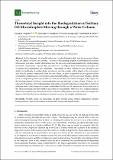Theoretical Insight into the Biodegradation of Solitary Oil Microdroplets Moving through a Water Column
Author(s)
Paraskeva, Christakis A.; Kalogerakis, Nicolas; Doyle, Patrick S.; Kapellos, George; Paraskeva, Christakis; Kapellos, Georgios; Doyle, Patrick S; ... Show more Show less
Downloadbioengineering-05-00015.pdf (8.482Mb)
PUBLISHER_CC
Publisher with Creative Commons License
Creative Commons Attribution
Terms of use
Metadata
Show full item recordAbstract
In the aftermath of oil spills in the sea, clouds of droplets drift into the seawater column and are carried away by sea currents. The fate of the drifting droplets is determined by natural attenuation processes, mainly dissolution into the seawater and biodegradation by oil-degrading microbial communities. Specifically, microbes have developed three fundamental strategies for accessing and assimilating oily substrates. Depending on their affinity for the oily phase and ability to proliferate in multicellular structures, microbes might either attach to the oil surface and directly uptake compounds from the oily phase, or grow suspended in the aqueous phase consuming solubilized oil, or form three-dimensional biofilms over the oil–water interface. In this work, a compound particle model that accounts for all three microbial strategies is developed for the biodegradation of solitary oil microdroplets moving through a water column. Under a set of educated hypotheses, the hydrodynamics and solute transport problems are amenable to analytical solutions and a closed-form correlation is established for the overall dissolution rate as a function of the Thiele modulus, the Biot number and other key parameters. Moreover, two coupled ordinary differential equations are formulated for the evolution of the particle size and used to investigate the impact of the dissolution and biodegradation processes on the droplet shrinking rate.
Date issued
2018-02Department
Massachusetts Institute of Technology. Department of Chemical EngineeringJournal
Bioengineering
Publisher
Multidisciplinary Digital Publishing Institute (MDPI)
Citation
Kapellos, George et al. "Theoretical Insight into the Biodegradation of Solitary Oil Microdroplets Moving through a Water Column." Bioengineering 5, 15 (February 2018) © 2018 The Author(s)
Version: Final published version
ISSN
2306-5354